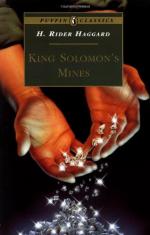Presently we came to the first company, and were able to gaze in astonishment on the most magnificent set of warriors that I have ever seen. They were all men of mature age, mostly veterans of about forty, and not one of them was under six feet in height, whilst many stood six feet three or four. They wore upon their heads heavy black plumes of Sakaboola feathers, like those which adorned our guides. About their waists and beneath the right knees were bound circlets of white ox tails, while in their left hands they carried round shields measuring about twenty inches across. These shields are very curious. The framework is made of an iron plate beaten out thin, over which is stretched milk-white ox-hide.
The weapons that each man bore were simple, but most effective, consisting of a short and very heavy two-edged spear with a wooden shaft, the blade being about six inches across at the widest part. These spears are not used for throwing but like the Zulu “bangwan,” or stabbing assegai, are for close quarters only, when the wound inflicted by them is terrible. In addition to his bangwan every man carried three large and heavy knives, each knife weighing about two pounds. One knife was fixed in the ox-tail girdle, and the other two at the back of the round shield. These knives, which are called “tollas” by the Kukuanas, take the place of the throwing assegai of the Zulus. The Kukuana warriors can cast them with great accuracy to a distance of fifty yards, and it is their custom on charging to hurl a volley of them at the enemy as they come to close quarters.
Each company remained still as a collection of bronze statues till we were opposite to it, when at a signal given by its commanding officer, who, distinguished by a leopard skin cloak, stood some paces in front, every spear was raised into the air, and from three hundred throats sprang forth with a sudden roar the royal salute of “Koom.” Then, so soon as we had passed, the company formed up behind us and followed us towards the kraal, till at last the whole regiment of the “Greys”—so called from their white shields—the crack corps of the Kukuana people, was marching in our rear with a tread that shook the ground.
At length, branching off from Solomon’s Great Road, we came to the wide fosse surrounding the kraal, which is at least a mile round, and fenced with a strong palisade of piles formed of the trunks of trees. At the gateway this fosse is spanned by a primitive drawbridge, which was let down by the guard to allow us to pass in. The kraal is exceedingly well laid out. Through the centre runs a wide pathway intersected at right angles by other pathways so arranged as to cut the huts into square blocks, each block being the quarters of a company. The huts are dome-shaped, and built, like those of the Zulus, of a framework of wattle, beautifully thatched with grass; but, unlike the Zulu huts, they have doorways through which men could walk. Also they are much larger, and surrounded by a verandah about six feet wide, beautifully paved with powdered lime trodden hard.




